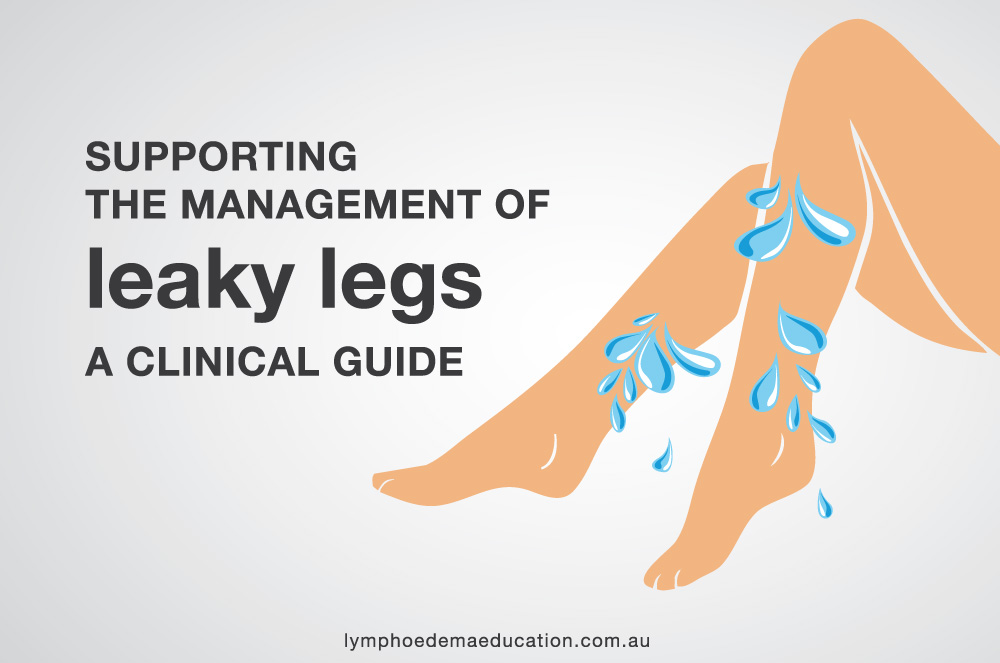Supporting the Management of Leaky Legs: A Clinical Guide
Author: Maree O’’Connor: Lymphoedema Physiotherapist
Contribution from Stacey Bradshaw: Lymphoedema Occupational Therapist, Rebecca Christensen: Occupational Therapist, Lymphoedema Practitioner, Greer Hosking: Clinical Nurse Consultant, Wound, Lymphoedema Practitioner, Cassandra Luke: Nurse Practitioner, Lymphoedema Practitioner, and Lyn Thomas: Nurse Practitioner, Wound Management
Lymphorrhea – the persistent weeping of lymphatic fluid through the skin – presents a significant challenge in lymphoedema care. It can compromise skin integrity, affect mobility and hygiene, increase the risk of infection, and lead to distress for both patients and carers. Despite its prevalence, it is often under-recognised or poorly managed in clinical settings.
This article brings together the insights and experiences of expert wound / lymphoedema health professionals to offer a practical guide to recognising, assessing, and managing lymphorrhea. It outlines key clinical indicators, evidence-informed management strategies, and the day-to-day challenges that affect patient care. The aim is to support fellow practitioners with a clear, consolidated resource to improve outcomes for those living with this complex condition. Central to these strategies is the effective use of compression therapy, consistently identified by lymphoedema health professionals as the cornerstone of successful lymphorrhea management and the intervention most likely to produce rapid improvement in fluid control and skin health.
Top Tips
We asked experts for their top tips for managing lymphorrhea in people with swollen legs.
Stacey Bradshaw:
- Compression: Ensuring proper compression is key, as it can resolve lymphorrhea fairly quickly.
- Moisture Management: Using a high-quality super absorber in the early stages to absorb excess moisture and keep it away from the skin.
- Skin Protection: Applying a good barrier cream or film to prevent skin maceration and damage, which could lead to wounds.
Rebecca Christensen
- Elevation: Prioritizing elevation to reduce swelling and leakage.
- Use of Excellent Absorbent Dressings: Ensuring dressings keep fluid away from the skin.
- Compression: Starting with well-fitting compression, as even minimal compression is better than none.
Greer Hosking
- Compression: Start with what the patient can tolerate and gradually increase.
- Wound Care: Address wounds, if present, effectively to manage lymphorrhea.
- Skin Care: Focus on preventing skin deterioration and excoriation.
Cassandra Luke
- Use of Appropriate Dressings and Skin Protection: Ensure proper dressings and skin care measures are in place.
- Skin Hygiene: Maintain cleanliness and care for the skin.
- Compression Therapy: Implement effective compression therapy to manage swelling and leakage.
Lyn Thomas
- Manage the Cause: Address the underlying issue causing lymphorrhea.
- Compression: Use appropriate compression therapy.
- Elevation/Activity: Encourage elevation and physical activity to reduce swelling and improve lymphatic flow.
Identification and Assessment
Assessing Severity of Lymphorrhea
Clinicians assess severity using several indicators:
- Volume and Frequency of Exudate – How quickly dressings become saturated, how often they need to be changed, and the presence of strikethrough all signal fluid burden.
- Skin Integrity – The presence of maceration, excoriation, wounds, cellulitis, or infection indicates more advanced lymphorrhea.
- Impact on Function and Quality of Life – The extent to which leakage affects comfort, mobility, or daily activities is also used to guide intervention.
- Objective Measures – Some clinicians use baseline lymphoedema assessment tools such as limb circumference or bioimpedance, alongside quality-of-life questionnaires and wound care assessments, to guide severity classification.
- Descriptive Classification – While terms like mild, moderate, severe are used, many clinicians prefer descriptive documentation covering dressing needs, fluid characteristics, and skin outcomes.
Early Indicators to Watch For
- Oedema and Swelling – Fluid leakage alongside swelling should prompt closer assessment.
- Skin Changes – Redness, irritation, or mild maceration can quickly escalate if untreated.
- Dressing Saturation – Frequent saturation or visible strikethrough may indicate early or worsening lymphorrhea.
Distinguishing Severity Levels Under Compression
- Mild – Minimal leakage; manageable with basic absorbent dressings and dressing changes every 2–3 days. Some clinicians change mild cases every 1–2 days if exudate volume is higher.
- Moderate – Requires daily or alternate-day changes; skin integrity may be compromised.
- Severe – High-volume leakage necessitating daily or twice-daily dressing changes, often with significant skin damage or infection risk.
Management
Early Referral
Timely referral is critical to effective lymphorrhea management. Early recognition of signs, combined with prompt initiation of compression therapy, helps prevent complications and supports faster healing. Escalating cases to lymphoedema specialists when needed ensures evidence-based, patient-centred care. Delays in referral can limit access to appropriate compression, hinder progress, and increase the risk of skin breakdown and infection.
Compression – The Cornerstone of Management
Compression is widely regarded as the most critical factor in resolving lymphorrhea, often producing noticeable improvement within days when applied effectively. It works by reducing oedema, supporting skin integrity, and helping to control fluid leakage.
The choice of compression should be guided by a thorough assessment of the patient’s comorbidities, lower limb oedema and vascular assessment together with their personal goals. Stiff short-stretch compression is often preferred for its ability to maintain consistent pressure, but the type, class, and wear regime will be guided by assessment and may need to evolve as the leg changes. It usually consists of either short stretch bandaging or compression wraps until the lymphorrhea has resolved. Followed by long term compression such as wraps or flat knit compression garments. Excessive dressing layers under compression should be avoided, as they can compromise pressure and reduce effectiveness.
Integration with dressings is essential. Low-profile, superabsorbent dressings that wick fluid away from the skin can be used to reduce bulk and improve comfort under compression. Dressing thickness should be factored into garment measurement to ensure a safe and effective fit.
Patient and carer education is equally important. Clear guidance on how to apply compression with the correct tension, where appropriate, and how to don and doff without disturbing dressings until the leakage resolves. Followed be explaining why consistent, daily use of compression matters to prevent recurrence. Education can address hesitancy and past negative experiences.
When correctly selected, applied, and integrated with appropriate dressings, compression does the heavy lifting in lymphorrhea management, reducing severity and supporting long-term skin health. Compression and dressings should be applied by health professionals with lymphoedema training to ensure safe and effective integration.
Preventing Maceration and Skin Breakdown
- Gentle Cleansing – Use pH-appropriate cleansers to reduce irritation and prepare the skin.
- Barrier Protection – Apply barrier creams or sprays (avoiding sprays on broken skin) to reduce maceration and preserve skin integrity.
- Appropriate Dressing Choice – Superabsorbent, non-adherent dressings help draw fluid away; antimicrobial options are used if infection is present. Choose the most cost-effective superabsorbent option available and to size it appropriately to the leaking area.
- Timely Application – Apply dressings and barrier products immediately after cleansing.
- Focus on High-Risk Areas – Prioritise protection of distal areas like ankles, where fluid often collects.
Integrating Dressings and Compression
Minimising Dressing Leakage
- Increase Dressing Frequency – Daily changes may be needed initially to manage high exudate levels; in severe cases this may increase to twice daily.
- Optimise Primary Dressing – Choose dressings with sufficient absorbency rather than layering less effective products.
- Maintain Compression Integrity – Encourage re-tensioning of wraps throughout the day as limb volume decreases.
- Problem-Solving – If dressings are leaking, review elevation habits, compression use, and any barriers to adherence.
Choosing Compression in Lymphorrhea
- Thorough Assessment – Consider vascular status, dexterity, and past experiences.
- Preferred Compression Types – Short-stretch cohesive bandaging or adjustable wraps are often more suitable than pullover garments.
- Avoiding Moisture Trapping – Compression garments are generally avoided during active weeping to prevent moisture accumulation.
- Pairing with Dressings – Use highly absorbent dressings under compression; adjust frequency as control improves.
- Adapt Over Time – Compression choice will likely change as the leg volume reduces and leakage comes under control, requiring flexible thinking around type, class, and wearing regime.
Elevation
Elevation is a critical step in reducing lymphorrhea. Raising the limb above heart level as often as possible helps reduce swelling and fluid leakage. This is most effective when paired with compression therapy to maintain the gains achieved through elevation.
Key Challenges in Management
Clinical and Patient Barriers
- Knowledge Gaps – Many clinicians lack adequate understanding of lymphorrhea, leading to delayed or ineffective care.
- Access to Products – Patients often face limited access appropriate trained health professionals and to appropriate effective compression and dressing products, especially in home settings. Cost is also a barrier.
- Compression Application – Patients may avoid compression due to discomfort or poor past experiences. Incorrect application can cause harm or fail to manage the condition.
- Therapist Adaptation – Some clinicians struggle to adjust their usual compression choice to meet the specific needs of patients with lymphorrhea. Home and Aged Care Considerations
- Maintaining Hygiene – Ongoing weeping complicates hygiene. Access to clean linen, clothing, toe washers, and disposable protectors is essential. Assessment of the home environment can help identify realistic changes to support healing.
- Falls Risk – Leaked exudate can create slip hazards, particularly on hard floors.
- Inconsistent Care – Ineffective management and variability in home or aged care support increases the risk of complications like cellulitis.
Supporting Patients and Carers
- Education – Explain why lymphorrhea occurs and why proactive appropriate management is critical. Use teach-back techniques and offer materials in multiple formats, including verbal, written, and GP referral letters.
- Practical Tools – Together with encouraging the need for keeping their compression on also encourage gentle cleansing, regular moisturising, leg elevation, and mobility. Podiatry care is also beneficial.
- Emotional Support – Validate patient concerns, track progress (e.g., limb size or wound healing), and end each session with encouragement.
Conclusion
Effective lymphorrhea management requires early recognition, careful assessment, coordinated care, and patient-centred education. While products and protocols play a role, appropriate compression therapy remains the single most influential factor in reducing leakage, protecting skin integrity, and restoring function. It is the clinician’s understanding, vigilance, and communication that often make the greatest difference.
Thanks to the contributions of Stacey Bradshaw, Rebecca Christensen, Greer Hosking, Cassandra Luke, and Lyn Thomas, this guide reflects real-world clinical experience and offers strategies grounded in current best practice. By addressing gaps in knowledge, improving consistency of care, and supporting both patients and carers, clinicians can reduce the burden of lymphorrhea and help restore comfort, confidence, and quality of life. When applied correctly and integrated with elevation, absorbent dressings, and patient education, compression therapy underpins almost every successful outcome in lymphorrhea management.
🔍 Clinical in Focus
Real-World Case Study: Managing Chronic Lymphorrhea in a Community Setting
Explore how a coordinated, patient-centred approach helped improve outcomes for a 76-year-old woman with persistent weeping, skin breakdown, and compression challenges.
This detailed case study brings the principles in this article to life – covering assessment, practical management, and systemic barriers in home care.
Case Study: Managing Chronic Lymphorrhea in a Community Setting
Patient Overview
Name: Margaret, 76 years old
Medical History: Long-standing bilateral lower limb lymphoedema, type 2 diabetes, osteoarthritis, hypertension
Living Situation: Lives alone with home care support three days per week
Referral Reason: Referred to lymphoedema clinic by GP due to ongoing lower leg weeping, dressing leakage, and skin breakdown.
Identification and Assessment
On presentation, Margaret reported persistent clear fluid weeping from both lower legs, particularly around the inside ankles. The weeping had increased over the past two weeks and was now soaking through her dressings and tubular bandage daily, requiring unscheduled visits from home care.
Clinical Assessment
Oedema in both legs below her knee with skin folds around her ankle. Inappropriate tubular, high stretch bandage on both legs from the ankle to the knee which was rolling and causing a tourniquet just below the knee. There was no compression on the feet.
- Exudate volume: High – primary dressings saturated within 2 hours, with strikethrough onto outer clothing and bedding.
- Skin integrity: Moderate to severe maceration present on both legs.
- Functional impact: Margaret was limiting her movement due to fear of leakage and reported sleeping in a chair to avoid wetting her bed.
- Classification: Bilateral chronic lower limb oedema with severe lymphorrhea – frequent dressing changes, compromised skin integrity, risk of infection, and significant impact on quality of life.
Management Strategy
A coordinated approach was developed with input from the lymphoedema therapist, community nursing, and Margaret’s GP.
Challenges Encountered Prior to Lymphoedema Health Professional Involvement
- Product Access – Margaret initial home care dressings didn’t include appropriate superabsorbent material. Supply delays impacted continuity of care.
- Hygiene and Falls Risk – Wet floors and footwear due to dressing leakage posed a safety hazard. Extra measures, such as absorbent bed and chair pads, were required.
- Emotional Distress – Margaret expressed embarrassment about visible leakage and odour. This reduced her social engagement and motivation to attend appointments.
- Consistency of Care – There was variability in compression technique and dressing product use among visiting nurses. This required regular communication and reinforcement of the management plan.
Initial Interventions
Cleansing and Skin Prep
- Switched to a pH-balanced, no-rinse cleanser to reduce irritation.
- Applied a silicone-based barrier film to surrounding skin to minimise maceration.
Dressing Selection
- Introduced a low-profile, superabsorbent dressing with horizontal wicking capacity.
- Added a non-adherent dialkylcarbamoyl chloride (DACC)-coated dressing to address suspected infection.
Compression Management
- Discontinued use of tubular, high stretch bandage.
- Initiated short-stretch cohesive bandaging applied by the lymphoedema therapist, with daily reapplication . After 3 days, dressing application changed to twice per week as the oedema was reducing and the leakage had considerably reduced. Regular limb measurements taken to monitor volume reduction and adjust compression accordingly.
Patient and Carer Education
- Provided visual and written materials on lymphorrhea, including hygiene strategies and signs of infection.
- Carer shown how to identify dressing saturation and when to seek support.
- Mobility encouraged through supported walking, seated leg elevation, and ankle pumps.
Outcome and Follow-Up
After three weeks:
- Lymphorrhea resolved, skin condition improved significantly, with resolution of maceration.
- Oedema reduction plateaued and fitted with flat knit below knee compression garments.
- Margaret’s confidence increased; she resumed sleeping in bed and was more mobile around the home.
Clinical Reflections
After three weeks:
- Lymphorrhea resolved, skin condition improved significantly, with resolution of maceration.
- Oedema reduction plateaued and fitted with flat knit below knee compression garments.
- System-level improvements in access to products and continuity across care settings.
Lymphoedema Education Solutions is grateful to the following companies for supporting this article – Click on the logos for relevant product information.







